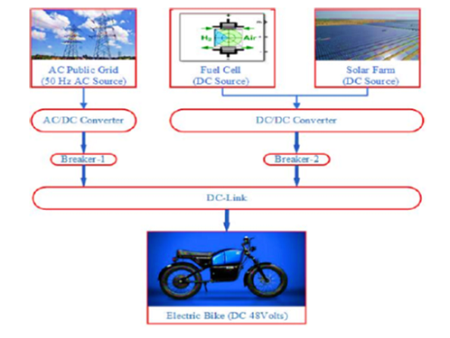


Indian Journal of Science and Technology
Year: 2021, Volume: 14, Issue: 30, Pages: 2517-2525
Original Article
Dheeraj Kumar Dhaked1*, Dinesh Birla1
1Department of Electrical Engineering, Rajasthan Technical University, Kota, 321408, India
*Corresponding Author
Email: [email protected]
Received Date:06 February 2021, Accepted Date:29 July 2021, Published Date:17 September 2021
Background/Objectives: One of the main objectives of this work is to design a microgrid for charging station of electric two-wheelers, which contains a public grid, fuel-cells (FCs) & solar PV plants as power sources. Methods/Statistical analysis: This work has used 6 kW Proton Exchange Membrane Fuel-Cells (PEMFC) and 6 kW solar PV plant with electric grid as a power source to incorporate a microgrid. The charging of EV battery is tested during different modes of operations and compared to each other. Findings: This paper describes that microgrid is eco-friendly and the use of solar PV & FCs in microgrid systems makes it more reliable & environment sustainable with power-efficient technologies simulated with MATLAB Simulink. Novelty/Applications: The proposed arrangement helps to create an efficient, low-cost, locally resilient microgrid. This will reduce the dependency on the electric grid during peak load time which is an imminent concern in cosmopolitan cities and which is novel contribution of this paper. This arrangement is also helpful when grid power is unavailable. The model was found to be satisfactorily charging the batteries used for two-wheeler and the charging rates of each method are compared to one another.
Keywords: Solar PV; FuelCell; Battery Charging; Electric Vehicles (EV’s);Microgrid
© 2021 Dhaked & Birla. This is an open-access article distributed under the terms of the Creative Commons Attribution License, which permits unrestricted use, distribution, and reproduction in any medium, provided the original author and source are credited. Published By Indian Society for Education and Environment (iSee)
Subscribe now for latest articles and news.